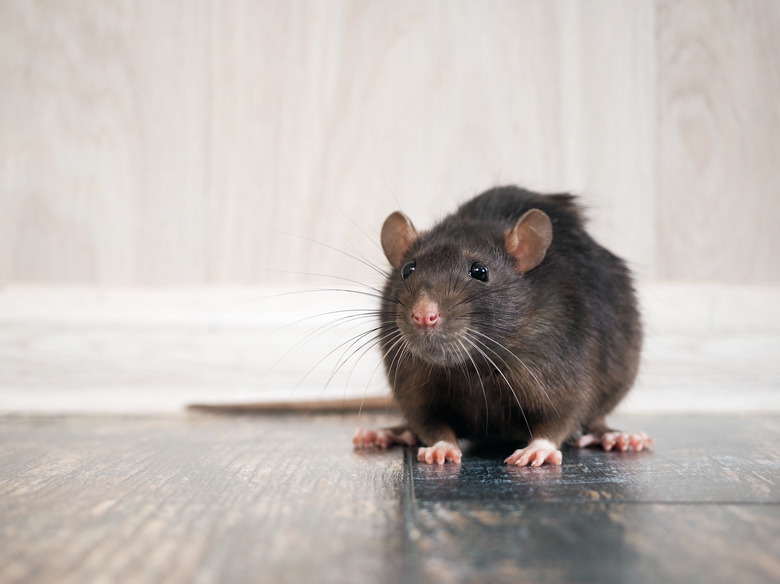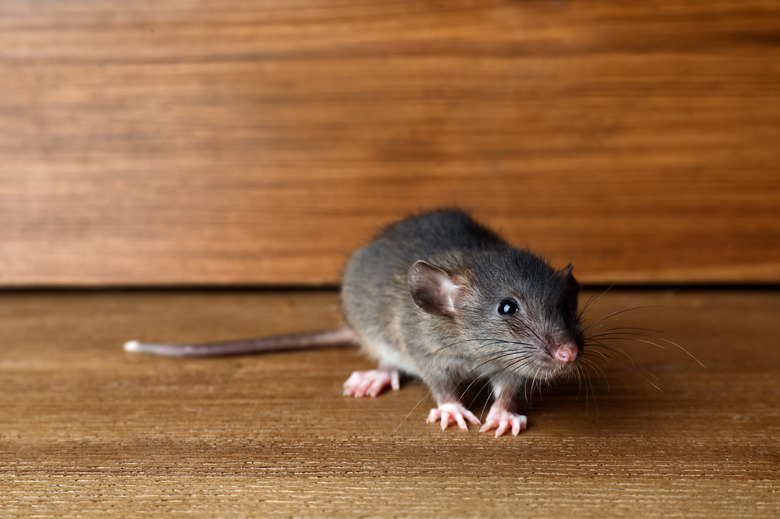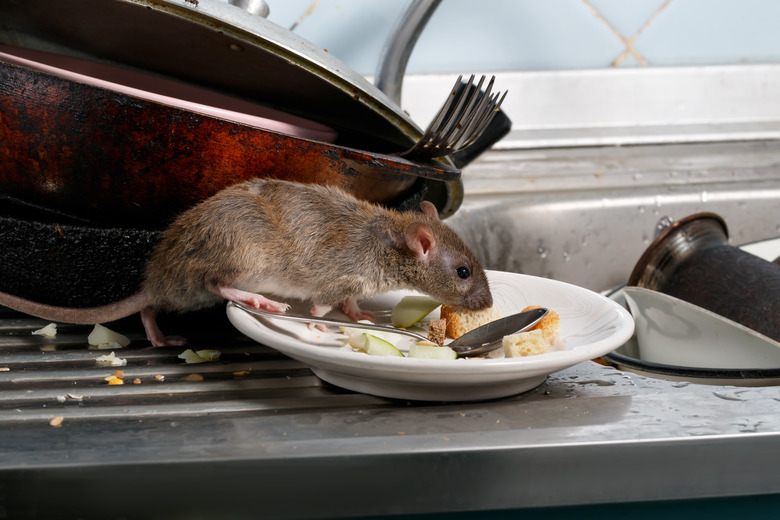How To Get Rid Of Rats In The House
We may receive a commission on purchases made from links.
It isn't always easy to get rid of rats, but it's something you have to do, even if you found the movie Ratatouille to be extremely charming. Rats are industrious, which is a quality to admire, but these qualities are more than offset by the damage they do and the disease they can cause. If you have a rat infestation, you have a real problem.
Rats are largely nocturnal, and the indoor varieties prefer to spend their days nestled in nests, often fashioned from your home's insulation. They will chew through wood to get into the insulation as well as through any electrical wires that happen to get in the way, creating power outages and fire hazards and necessitating expensive demolition just to find the damage. While nestled in the walls, rats reproduce at heroic rates and create unsanitary and smelly conditions, and they duplicate these conditions in your kitchen and pantry whenever they're hunting for food. Rats spread disease, and while the era of bubonic plague is thankfully long past, the pathogens they carry can still put you in the hospital.
A responsible pest management strategy for rats consists mainly of exclusion, cleaning, and trapping, and it relies on rat poison only as a last resort. Rodenticides can harm predators and even enter the food chain through them. They can also harm unwary pets and other animals and are generally dangerous enough to warrant rodenticide restriction in such states as California and Michigan. The EPA has issued a nationwide ban on pellet-type rodenticides that aren't deployed in bait stations to make them inaccessible to other animals and children. Trapping is a safer means of indoor control (safer for people, not rats), and there are many natural deterrents that homeowners can use both indoors and outside.
How to Prevent Rats in Your House
How to Prevent Rats in Your House
Of course, the best way to get rid of rats is to completely prevent them in the first place. If you're not dealing with a full-on infestation, here are a couple of ways to spare your home from rat damage and disease:
Inspect Your House and Seal Openings
Rats can fit through openings about the size of a quarter, so use caulk or expanding foam to seal these openings, or if they are too large for that, seal them with cement or with hefty, gnawproof wire mesh or metal plates. Don't use wood because they will gnaw through that. Look for holes in both the interior and exterior walls and especially in the basement or crawl space.
Keep Your House Clean
Store food in the refrigerator or in ratproof containers made of glass, metal, or thick plastic with tight-fitting lids. Sweep the floors often to remove any crumbs that rats might consider a food source, and de-clutter wherever possible to deprive rats of hiding places.
How to Get Rid of Rats
How to Get Rid of Rats
When people picture a rat infestation in the home, they often think of swarms of little creatures in the pantry, but rats tend to be more elusive. You'll know the rats are in your house by the appearance of smudges and gnaw marks on the woodwork, bite marks on food containers, and droppings in places they frequent, often behind the refrigerator and in other dark, inaccessible parts of the house. The best time to initiate a control is before they get into your house, but if they're already there, you can still do plenty to get rid of rats.
Deploy Rat Traps
Trapping rats isn't fun for anyone, but it's safer and more reliable than baiting. Snap traps are the most effective, but the old-style wire traps often catch a portion of the creature and leave it to scurry around with a trap attached to its foot. Glue traps are more effective, but these traps can produce the same results. Plastic snap traps baited with peanut butter or cheese are the most likely to be lethal and are easy to set but be sure to attach the trap to a solid object with a length of wire so the rat can't run away to die in a hiding place, bringing the trap with it.
Some other trapping options include electronic traps, which are bait stations that zap any rodent that ventures inside with a lethal dose of electricity or — for the humanely minded — live traps that allow you to relocate the pests elsewhere. The main problem with live traps is that it can be difficult to find a place far enough from the house to release them without creating a rat problem for someone else.
Room-by-Room Rat Control
Rats are most likely to frequent eating areas, like the kitchen or dining room, because that's where the food is located. They won't come when you're around, of course, and the best way to prevent them from coming at all is to store food safely and clean up after each meal. Schedule feeding times for your pets and put away the pet food at other times. Your dogs might whine, but they'll get used to it.
If you're having a rat problem in a bedroom, it's likely because the rats have found a cushy place to hide, perhaps in a drawer full of socks or in a pile of clothes. Clean your drawers regularly and put away clothes you aren't using. If you still see signs of activity, deploy one or two snap traps in places where the activity is noticeable.
Rats in walls can be especially vexing; you can hear them scratching and scurrying, but you can't see them. One possible way to deal with them is to look for an entry point, which may be marked by bits of insulation or smudged walls. Seal all other parts of the wall but that one and set a trap. If you catch a rat, keep setting the trap until you stop catching rats.
How Long Does Control Take?
Rodent control doesn't happen overnight. If you have an active infestation, you'll have to set traps vigilantly for several weeks. If you think setting bait stations to poison the critters is faster, you're probably right, but think of where those rats are going to die. That's right — behind your walls, where they will decompose and create a mess and a stench. Although trapping is slower, you'll be able to safely dispose of the rats you catch, or you can release them, and you won't have any dead rats in your walls.
Do You Need a Pro?
A homeowner with a severe rat infestation who isn't having success with DIY measures shouldn't hesitate to call a local pest exterminator or pest control company. There's one in every metropolitan area and in most smaller towns as well, and the cost is typically from $100 to $500 depending on the size of the house and the severity of the problem. Ask for a free quote. Exterminators may trap or bait rats, and they'll also help you seal all the entry points in your home properly so the rats never return.
Getting Rid of Rats Naturally
Getting Rid of Rats Naturally
Do you still think rats are too cute to kill? You're not alone, and people of this persuasion are the most likely to use a live trap, one version of which is a rat-size box or cage with a door that swings shut and locks when a rat goes in to take the bait. Another version is a 5-gallon bucket fitted with ramps and a revolving lid. This live trap dumps rats into the bucket when they climb the ramp to try to reach the bait. The bucket trap is more suitable for a large infestation because it can catch several rats at one time.
Rats hate the smell of peppermint, so you can keep them away by spraying a solution of peppermint oil and water or spreading crushed peppers in places where you've seen signs of rats. (In fact, peppermint plants around the foundation of the house can be an effective repellant for rats.) Plug-in rat deterrents can also help. Some broadcast aromas you like but rats don't, while others broadcast ultrasonic noise that you can't hear but the rats can. You can mix and match these and other deterrent measures until you find a combination that works.
What Do Rats Look Like?
What Do Rats Look Like?
- Species name: Rattus
- Physical characteristics: From 5 to 15 inches in length with black to light brown coloration.
- Color/species varieties: The brown rat (Rattus norvegicus), also known as the Norway rat or sewer rat, is large with coarse brown or gray fur. The black rat (Rattus rattus), also known as the ship rat or roof rat, is smaller with a maximum length of 7 inches and has black or brown coloration and long ears. The wood rat (Neotoma), also known as the packrat, is an outdoor species that is typically grayish-brown and about the size of a black rat.
- How to tell rats from mice: Rats are generally larger than mice and have larger feet but smaller ears. Rats have fairly large, hairless tails, while mice have long, slender tails that are covered in hair.
How Rats Get in Your House
How Rats Get in Your House
The two most common indoor species of rats are the black rat and the brown rat. Black rats tend to make their nests in high places, preferring tree branches while in the wild, and they are the ones most likely to be found in attics. Brown rats, on the other hand, prefer to build nests on low ground and are the species most likely to be found on ground floors or in basements. Both types of rats can get into a house through any opening through which they can fit.
Gardeners have to be on the lookout primarily for wood rats, which build nests out of branches, sticks, and twigs; in ground burrows; and sometimes in trees. Known for their penchant for hoarding bright, shiny objects in the nests (which is why they are called packrats), they prefer to stay outside, where they can cause extensive damage to gardens, mostly at night but sometimes during the day. Unlike house-dwelling rats, which are active all year, wood rats are most active when the weather is warm, although they do not hibernate and may be seen in cold weather.
With a gestation period of less than a month, female rats reproduce prolifically. Litters can number as many as 22, and a single female rat can give birth to as many as 2,000 babies in a single year. It's important to address a rat infestation early because rat populations can quickly get out of control.
Do Rats Cause Damage or Spread Disease?
Do Rats Cause Damage or Spread Disease?
Indoor rats can cause extensive damage to house insulation, wiring, and ductwork, and their droppings create unsanitary conditions in places they frequent. Signs of indoor rat damage include scattered insulation, electrical circuits that suddenly lose power, chewed food packets, and, of course, droppings. Outdoor rats can decimate crops, empty bird feeders, and contaminate gardens. If they have access to a water source, they will contaminate that as well.
Besides their penchant for causing damage to the home and garden, rats are notorious vectors of disease, some of the most serious being typhus, Weil's disease, toxoplasmosis, and trichinosis. They also spread hantavirus (which has a mortality rate of 38 percent), leptospirosis, and hepatitis E. The black rat was primarily responsible for the spread of bubonic plague, which is carried by fleas.
References
- United States Environmental Protection Agency: Restrictions on Rodenticide Products
- Country Living: How to Get Rid of Rats in the Home
- The Critter Squad: How Much Does It Cost to Get Rid of Rats?
- Smith's Pest Management: How To Get Rid Of Rats In Your Home Fast: A Complete Guide [2021]
- AutomaticTrap.com: Rats


